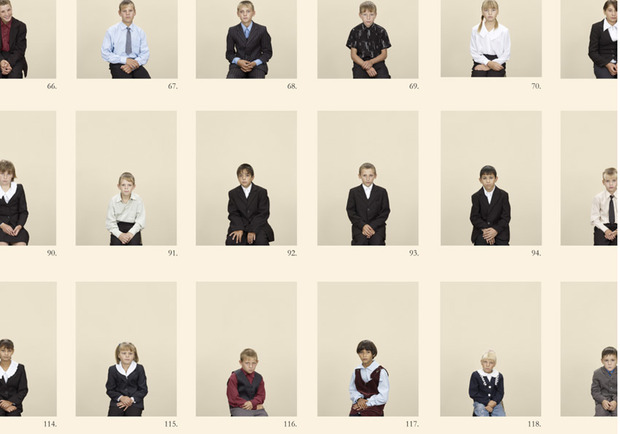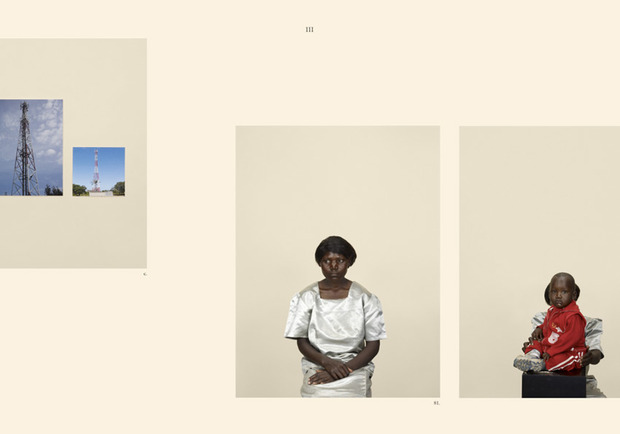Taryn Simon: A Living Man Declared Dead and Other Chapters I – XVIII
Family trees flung all over the world captured in photos at MoMA


Taryn Simon is part bloodhound, part photographer. For “A Living Man Declared Dead and Other Chapters I – XVIII,” she spent four years tracking down 18 families spread all over the world. Nine of those families, or chapters, as Simon calls them, are now on display at MoMA. Each chapter is made up of three segments, most notably a large group portrait shot yearbook-style with each family member photographed individually. “In each of the 18 chapters,” Simon explains, “you see the external forces of territory, governance, power and religion colliding with the internal forces of psychological and physical inheritance.” The sequence is arranged in order of the oldest living ascendants followed by their living descendants. This orderly family tree is accompanied by a short text and footnote images that add to the narrative.

This extremely organized coding system belies the complicated and, at times, even messy process of tracking down family members and getting them to agree to be photographed. Take the living descendants of Hans Frank, Hitler’s legal advisor and Governor-General of occupied Poland. In addition to his involvement in setting up Jewish extermination camps, Frank oversaw campaigns to destroy Polish culture by massacring thousands of Poles, all of which he denied when he was brought to trial at Nuremberg and subsequently executed. As you might imagine, his children and relatives aren’t exactly bragging about their family name, and most refused to participate in Simon’s project. Those who agreed to be photographed don’t exactly look thrilled to be there.
Not every bloodline is so full of holes. Joseph Nyamwanda Jura Ondijo’s polygamous Kenyan family is brimming with 32 children and 64 grandchildren, courtesy of his nine wives, most of whom he met through his practice, where he treats patients suffering from a wide range of ailments from evil spirits to HIV/AIDS. Ondijo is usually paid in cows and goats, but sometimes, when a family can’t afford that, they offer a daughter instead. Five of his wives came to him as patients; Three were plagued by evil spirits, one had asthma and two were suffering from infertility (they were cured and bore him children).

Reading about the Frank or Ondijo family, or about the stories in Simon’s other chapters—an over-crowded, underfunded Ukrainian orphanage, for example—is one thing, but seeing the faces of these people, and in one chapter, the animals, is something else altogether. In grid form, one right after the other, it becomes not so much about the similarities among relatives in each chapter, but how they’re so surprisingly unique—and depressing. Homi Bhanha notes in “Beyond Photography,” his essay about the exhibition, that “a precarious sense of survival holds together the case studies…It is the extremity of such precariousness that sets the stage upon which the human drama of survival unfolds…Survival here represents a life force that fails to be extinguished because it draws strength from identifying with the vulnerability of others (rather than their victories), and sees the precarious process of interdependency (rather than claims to sovereignty) as the groundwork of solidarity. We are neighbors not because we want to save the world, but because, before all else, we have to survive it.”

Simon’s subjects show that struggle for survival. Even the children look world-weary. With few exceptions, every slumped figure looks irrepressibly sad. Maybe it’s the bandaid-colored backdrop she used as what she calls “non-place, a neutral cream background that eliminates and erases any environment or context,” that renders the emotionless faces so flat. Collectively, Simon’s work sucks the energy right out of the room. Though it’s true that your DNA only determines part of who you are and that the rest is your own making, the subjects here look resigned to accept the fate of their forefathers. In fact, you can’t help but be touched by the overwhelming emptiness that pervades the room. Though the title refers specifically to one chapter in which a living man is declared dead on paper so that a distant relative can inherit his land, Simon hopes it acts as a metaphor for the entire show, noting that “We are all steadily heading toward death.”
“A Living Man Declared Dead and Other Chapters I – XVIII” is on display at MoMA until 3 September 2012.











